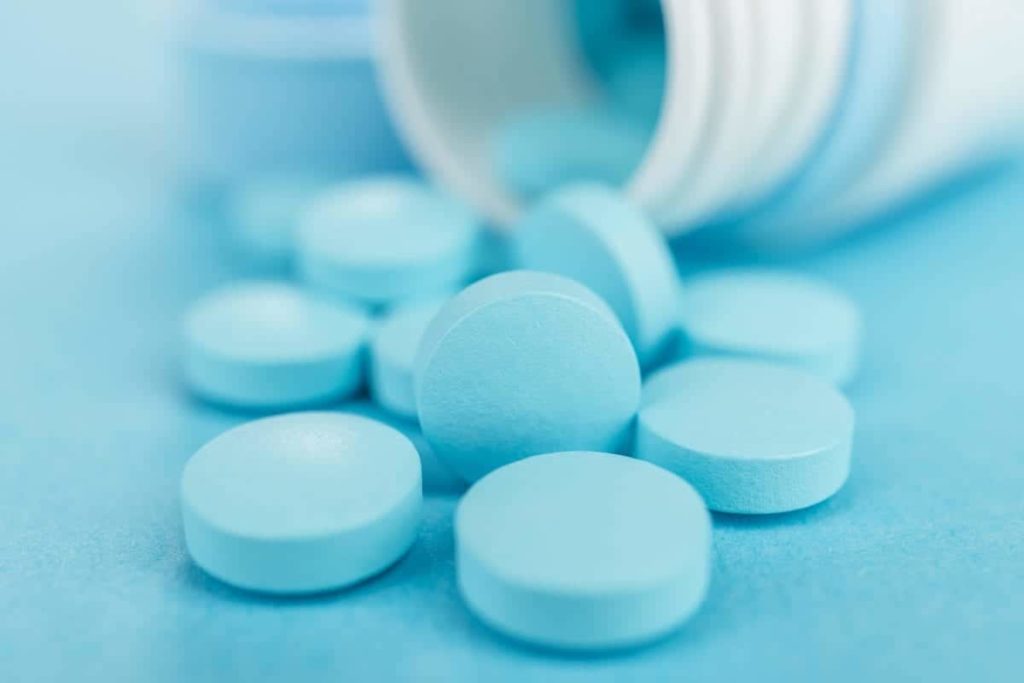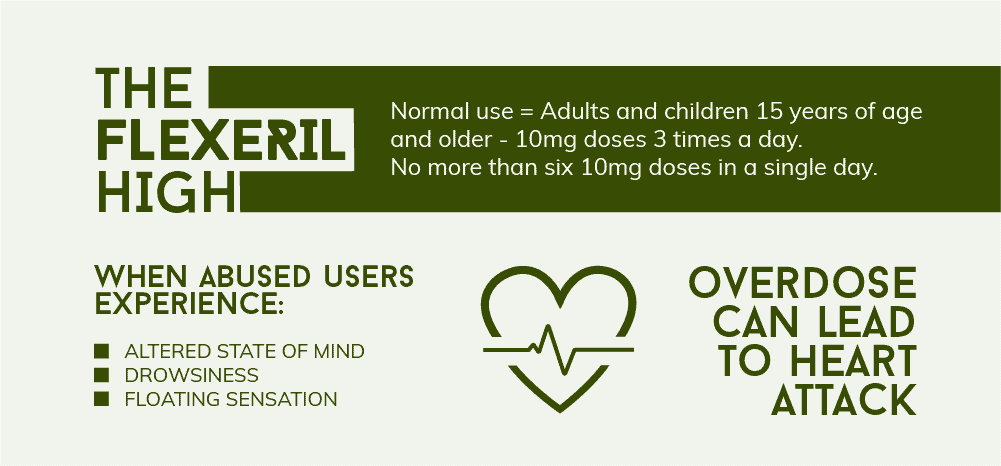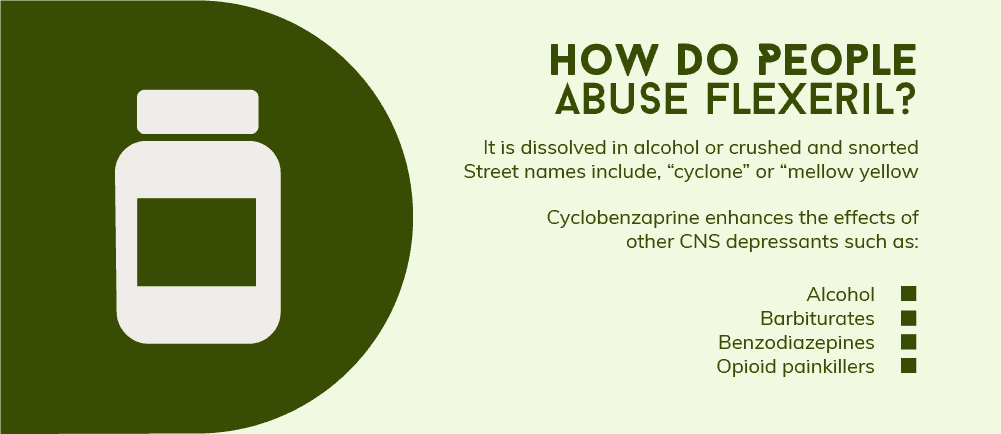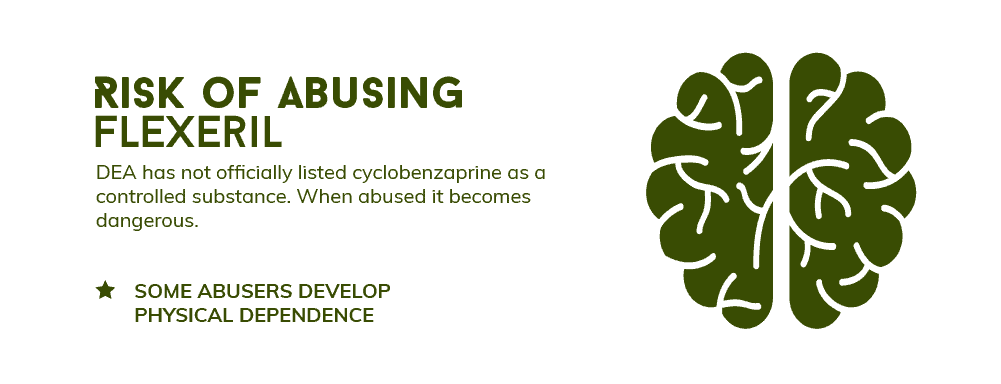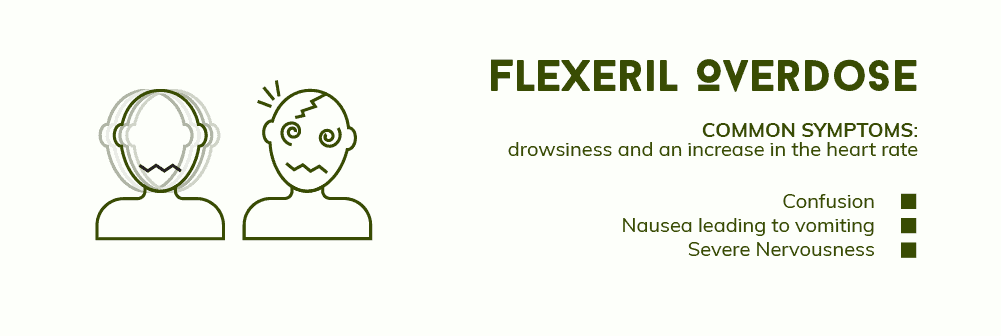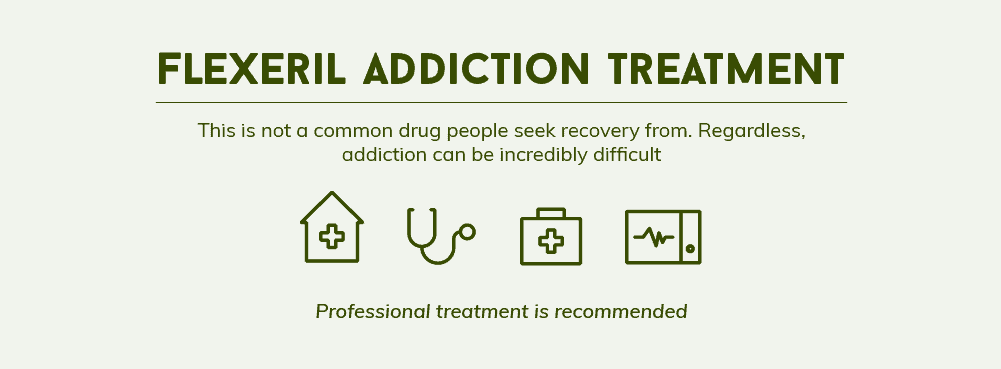The DEA found that nearly 25 million prescriptions were given out for cyclobenzaprine, the active ingredient in Flexeril. As a muscle relaxant, it is often used for back pain. Flexeril is believed to be much less addictive than other pain killers. The technical name of the active compound in Flexeril is cyclobenzaprine which can be found in a variety of different products. The Flexeril dosage comes in Flexeril 5 mg and Flexeril 10 mg tablets. Fexmid is a brand name tablet that comes in a 7.5 mg tablet. There are also generic Flexeril and Fexmid options. Amrix is an extended-release capsule that can be taken once daily in a 15 mg – 30 mg dose.
“Get your loved one the help they need. Our program accepts many health insurance plans, this is our residential program.”
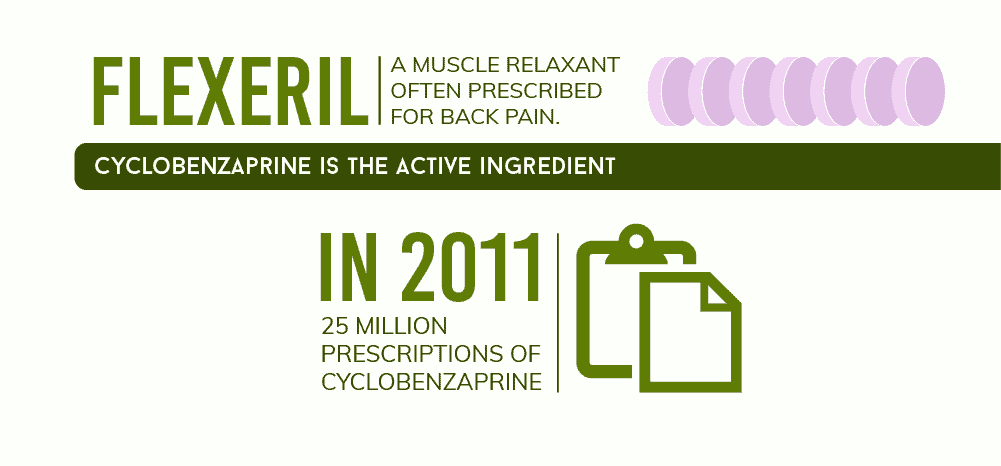
The Flexeril High
The physical effects of Flexeril include relaxation to the muscles. If a person is experiencing muscular pain from an injury, Flexeril controls the spasms that result in pain. It produces a relaxing effect that one might consider a Flexeril high. If the dosage is tampered with, that will end up causing greater cyclobenzaprine high. A Flexeril high is really only possible when the medication is abused or when the patient first takes it. Some users, however, have If someone takes more than the prescription suggests, the Flexeril high can include an altered state of mind. The user may feel a sense of floating. A Flexeril overdose can cause severe health problems. It can lead to cardiac arrest, a dangerous drop in blood pressure, or seizures. Less common issues include central nervous depression. One of the more common effects of the Flexeril high is drowsiness. That’s about as intense as the Flexeril high gets. The dangers of taking more than prescribed are much greater than the reward of abusing it.
Proper Flexeril Dosage
Given the potential for abuse of this drug, it’s important to know the proper dosage for this particular muscle relaxer. Most importantly, be sure to avoid using cyclobenzaprine and alcohol, opioids, benzodiazepines or any other central nervous system (CNS) depressants as the interactions could cause life-threatening side effects. You and your doctor will work out the proper cyclobenzaprine dosage for your particular situation. However, in general, physicians will prescribe Flexeril dosages according to the guidelines below as provided by the Mayo Clinic.
- Adults and children 15 years of age and older – Flexeril 10mg doses 3 times a day. The largest amount should be no more than six Flexeril 10mg doses in a single day.
- You may also start out on Flexeril 5mg doses 3 times a day in order to test your body’s reaction to the drug as well.
- Specific dosages should be determined by the doctor for patients with certain health conditions that may cause complications (i.e. taking MAO inhibitors, have liver problems, are taking other CNS depressants such as Valium, etc.).
Whether you’re taking Flexeril 5mg doses or are on cyclobenzaprine 10mg pills, the fact is that you should always follow your doctor’s exact orders when it comes to taking this drug.
What is the Flexeril High Like?
People who have never taken Flexeril may wonder what the draw is for cyclobenzaprine high rather than one from another drug. The Flexeril high itself isn’t quite as euphoric as it is with other drugs. However, it does produce a long-lasting feeling of relaxation and calmness that many substance abusers can find quite appealing. This is what compels regular users to continue to experiment with it. Like other drugs, this Flexeril high usually scales with both the dosage used (i.e. a cyclobenzaprine 10mg high will be more intense than a cyclobenzaprine 5mg high) as well as with the number of other drugs taken at the same time. It might be helpful to read one user’s account of a recent Flexeril trip. They were kind enough to share it with us:
My Flexeril High Experience
I can remember the first time I took Flexeril. I had been prescribed this drug for back pain and to help with muscle spasms. It is a very powerful muscle relaxer, and it works quite well. It occurred to me that it might work even better if I used a little more than I normally would. So, one day, I decided to give it a try. I waited until I had a couple of days when I would be at home, by myself. When I only took Flexeril 10mg, it produced a type of “hangover” effect the next day. I knew I had to allow for that to happen this time too. I woke up in the morning and I took one 10mg tab of Flexeril, sat back and waited for the high. It can take between 45 minutes to 1 hour to feel the effects of Flexeril begin to kick in. At first, I only felt a very mild feeling of sedation. My mind and my body became relaxed and I felt really good. I took a second dose about an hour later. I was already feeling very calm and it seemed like every muscle in my body was relaxed. I felt the second dose kick in about two and a half hours after I started. The sedation I felt was extreme and I felt very relaxed. It was almost as if it would be too difficult for me to even move. I started to get tired, but I fought that feeling off. I wanted to continue to enjoy the high. About three hours in, I started having some visual hallucinations. I thought I saw someone standing in my bedroom, and it looked like a child. However, all I could really see was a dark outline. I kept seeing bright flashes of light that were gone before I could even register that I had seen them. It wasn’t long after that when I fell asleep. At that point, I needed it, and I slept for seven hours straight. A friend woke me up later. I was still in a daze, and I didn’t take any more of the drug. I guess at that point, I really didn’t feel like I could. I did drink some alcohol when it was offered to me, and the strangest thing happened. I was sitting on the sofa in the living room, and after some time, I couldn’t move my legs. It was as though I was paralyzed. They didn’t hurt at all, but it was like the connection between my legs and my brain had been severed. My friend helped me lie down and I fell asleep again. I slept there until the morning, at which point, I was still groggy, but at least I could move my legs. Getting high on Flexeril is kind of like being on a vacation. You have never felt such a feeling of relaxation in your entire life. However, it’s not something that I would do all the time. I can easily see how someone might become addicted to it though.
Is Flexeril a Narcotic?
Given the symptoms of a cyclobenzaprine high, you may be tempted to ask the question, “is Flexeril an opioid or is cyclobenzaprine a muscle relaxer of a different sort?” And the question isn’t an uncommon one. Many people believe that Flexeril is a narcotic similar to other painkillers like OxyContin, Fentanyl, or Vicodin based on how it makes you feel alone. However, the truth is cyclobenzaprine belongs to a separate class of chemicals known as a muscle relaxant. Rather than activating opioid receptors like other prescription painkillers, Flexeril instead blocks certain nerve impulses that are sent to the brain. Just because cyclobenzaprine isn’t an opioid though doesn’t mean it hasn’t become a substance of abuse.
How Do People Abuse Flexeril?
Can Flexeril make you high? It’s not as intense as other prescription pain killers but there is still the potential for an altered state. Flexeril abuse can lead to the user feeling sedated and relaxed. There is the possibility of a euphoric cyclobenzaprine high as well. Flexeril is not a narcotic but it can become quite dangerous when abused or mixed with other drugs. It can easily be dissolved in alcohol or crushed and snorted, making the Flexeril high much more intense. Cyclobenzaprine isn’t widely abused, though the high potential is there. When used for illicit purposes, the street names include, “cyclone” or “mellow yellow. Recreational Flexeril doses will be more like 20-80 mg. A prescription Flexeril generic dose is 5mg – 10 mg at one time. Primary effects when taking cyclobenzaprine recreationally include drowsiness and a feeling of relaxation. The Flexeril high can include a pleasurable feeling of muscle relaxation and a feeling of floating as well. The DEA has found that most people abusing Flexeril do so by mixing it with illegal or prescription drugs. This is because cyclobenzaprine enhances the effects of other CNS depressants such as:
- Alcohol
- Barbiturates
- Benzodiazepines
- Opioid pain killers
Risk of Abusing Flexeril
The DEA has stated there really is no risk when it comes to Flexeril. This is based on what the FDA approved the drug for. In fact, the DEA has not officially listed cyclobenzaprine as a controlled substance at all. However, when abusing Flexeril recreationally, it does become a greater risk to the user. In the first place, Flexeril abuse can end up causing an overdose, the effects of which can be incredibly dangerous. Dangerous fluctuations in body temperature, irregular heartbeat, and even convulsions are all possible from too much cyclobenzaprine recreational use. Flexeril recreational use can also end up leading to the development of physical dependency. This is marked by a need to use cyclobenzaprine regularly in order to simply function. And when this dependency gets out of hand, Flexeril addiction is possible, which can have long-term implications and health effects that can end up tearing apart your life as you know it. These two dangerous consequences of Flexeril abuse are exacerbated by the fact that mixing drugs with cyclobenzaprine can make Flexeril addictive and deadly on a whole new level. Taking Flexeril with MAOs puts a person at high risk of a dangerous medical condition. Serotonin Syndrome is life-threatening. It can occur when Tetracyclic Compounds and MAOIs both raise the level of serotonin too high in the body. It can cause changes in blood pressure, body temperature and lead to a change in behavior. To add to the risk of overdose, addiction, and mixing substances along with cyclobenzaprine recreational use, patients can also be extremely allergic to Flexeril which can cause the body to react quickly. If a person has an overactive thyroid, heart issues or problems with the liver, Flexeril can be risky and should not be taken.
“We treat both addiction and co-occurring disorders and accept many health insurance plans. Take a look at our inpatient program.”
Risks of Combining Flexeril and Alcohol
The combination of Flexeril and alcohol can cause serious problems in the central nervous system, the consequences of which may end up being fatal. The problem with combining Flexeril and alcohol comes from the fact that both of these drugs are actually central nervous system (CNS) depressants. That means that both Flexeril and alcohol have a tendency to slow down the body’s natural processes. One of the most important bodily processes that these two drugs can end up impacting is respiration. When used alone, alcohol can end up slowing respiration to deadly levels due to alcohol poisoning. Flexeril abuse can also end up leading to dangerously slow respiration. When Flexeril and alcohol are mixed, however, these qualities can actually end up overlapping, making the potentially fatal risk of low respiration even more likely to occur. The alcohol also increases the side effects of cyclobenzaprine. This includes dizziness, difficulty thinking, and drowsiness. As a result, they may be more likely to physically hurt themselves while abusing cyclobenzaprine and alcohol. It’s not advised to drink alcohol at all while they’re being treated with Flexeril. People that combine Flexeril and alcohol also may not think properly and are more susceptible to making bad choices. This can cause risk to the user. Operating a vehicle while intoxicated, walking through a bad part of town, and other risks to physical harm may end up being more likely when abusing Flexeril and alcohol. There have been a number of fatalities reported as a result of the Flexeril and alcohol combination that occurred from physical harm caused by over-intoxication.
Flexeril Overdose
A Flexeril overdose is possible. Common effects include drowsiness and an increase in the heart rate. Less common effects include:
- Tremors or seizures
- Agitation
- Falling into a coma
- Hypertension
- Slurred speech
- Confusion
- Drowsiness
- Dizziness
- Nausea leading to vomiting
- Hallucinations
- Severe Nervousness
- Muscle stiffness
- Trouble with breathing
Rarely, a Flexeril overdose can in fact cause life-threatening symptoms. These rare side effects from too intense of a cyclobenzaprine high include:
- Cardiac arrest
- Chest pain
- Cardiac dysrhythmias
- Severe hypotension
- Seizures
- Neuroleptic malignant syndrome
Usually, people won’t die from a cyclobenzaprine overdose. There are over 12,000 people in the U.S who will go to the emergency room looking to be treated for Flexeril overdose. A study showed that 209 people who overdosed on Flexeril on its own survived the ordeal. Mixing the drug with other substances, however, has shown to cause accidents leading to death.
Flexeril Side-Effects
Flexeril has the potential to cause severe nervous system problems as well as mental problems. This includes loss of muscle tone, disorientation, anxiety, and even psychosis. A common Flexeril side effect is drowsiness. People should avoid responsibilities that require alertness until they know how Flexeril will affect them. Some people may not experience a feeling of drowsiness while others may feel it intensely. Other common Flexeril side effects are nausea, dry mouth, and feeling dizzy. Flexeril has antihistamines in it which can cause some of the side effects. There is also the possibility of tolerance to the drug, so patients may have to take higher doses to feel the effects. This is where Flexeril dependency can occur. The brain will become accustomed to the constant presence of cyclobenzaprine, relying on it to function properly. As a result, cyclobenzaprine dependency can occur. Cyclobenzaprine recreational use can also increase the risk of developing Flexeril dependency and addiction. Flexeril has been found to cause liver damage if a person abuses the drug. The liver can become inflamed and swollen. A person can end up with jaundice or bile can be blocked from the liver into the intestines. Similar to severe alcohol abuse, then, Flexeril abuse can end up causing permanent and potentially life-threatening damage to the liver and other vital internal organs. Flexeril abuse can cause neurotransmitters to malfunction in the brain. This can cause:
- Confusion.
- Hallucinations.
- Problems seeing properly.
- Inability to think properly.
- Unusual thoughts and fears.
Other symptoms include:
- Difficulty breathing.
- Swelling of the lips, tongues, and throat.
Will Flexeril Show Up on a Drug Test?
Flexeril is not a narcotic and will usually not show up on a basic 5-panel drug screen. If the drug screen is testing for TCA’s, Flexeril may show up. This is because cyclobenzaprine has a chemical structure like a tricyclic antidepressant. However, a test for TCA isn’t that common. The 5-panel test is the general test used by employers and doctors. It includes meth, opiate, THC, Benzodiazepine, and cocaine. Cyclobenzaprine does show up in urine tests. It has a half-life of 18 hours so it will stay in the body for about 90 hours. This means it will show up on drug tests for nearly 4 days. If a person has liver or kidney problems, the drug may remain in the body for longer. This is because the liver will take longer to process the drug through. It’s important that someone on Flexeril let the test administrator know they’re taking Flexeril. This is because it can give false positives on other narcotic substances. For instance, a person may be seen as using cocaine when they’re not.
Is There a Risk of Flexeril Addiction?
If cyclobenzaprine is taken for the 14 days that is advised, there is very little risk of Flexeril addiction. When it’s abused or taken for prolonged periods, however, it can easily lead to addiction. Flexeril is considered to be a drug with abuse potential with addictive qualities. Flexeril isn’t classified by the DEA as a controlled substance, even though the drug can cause unpleasant withdrawal symptoms. As a result, the DEA doesn’t consider cyclobenzaprine abuse a high priority. The qualities of developing a Flexeril addiction are there, the high just isn’t rewarding enough when used on its own. If addicts can use a stronger drug, they would choose it over Flexeril. The dependence on cyclobenzaprine is proven by the withdrawal symptoms that occur once the medication leaves the bloodstream. Symptoms of Flexeril withdrawal include:
- Nausea.
- Headaches.
- Fatigue and general malaise.
There is also the possibility of becoming psychologically dependent on Flexeril because of the feelings of relaxation. Flexeril on its own may not be as susceptible to creating addiction but when it’s abused, there’s a much greater risk. And when cyclobenzaprine and alcohol, opioids, or drugs are used in combination, that risk becomes even higher. People will abuse cyclobenzaprine to enhance the effects of alcohol or mind-altering drugs. As a result, the cyclobenzaprine high can actually end up leading to the development of addictions to other drugs as well.
What Is Flexeril Discontinuation Syndrome?
One of the risks of Flexeril withdrawal includes Flexeril discontinuation syndrome. People who abuse Flexeril for years and in large amounts may develop the syndrome. The withdrawal syndrome with Flexeril is similar to when people try to stop using tricyclic antidepressants. Symptoms include:
- Flu-like symptoms.
- Nausea and vomiting.
- Sweating.
- Insomnia.
- Muscle aches.
This is often why people will be admitted into an addiction treatment clinic for Flexeril withdrawal. During cyclobenzaprine addiction treatment, the medication will be slowly tapered off by a reduction of amounts over a certain time frame. This can help patients avoid the discomfort of withdrawing from cyclobenzaprine.
Flexeril Can Be Abused but the High Isn’t Worth the Risk
Flexeril is not a narcotic. It’s not considered a dangerous method of getting rid of specific muscular pain. It is given to patients who are more likely to abuse opiate pain killers and is considered less risky for abuse and addiction.
While it can be abused if it’s mismanaged, it really isn’t worth the health risks the high offers. Regardless of the slight high, it gives to users, there is also the potential of becoming dependent on it. The slight relaxing feeling can become something that becomes a normal part of their everyday experience. When a patient becomes physically dependent on Flexeril, they’re often at a much higher risk of developing a cyclobenzaprine addiction further down the line. This addiction is marked by compulsive drug-seeking behaviors, even when the negative effects of these behaviors are fully recognized.
Flexeril Addiction Treatment
This is a drug that isn’t usually considered one of the more common drugs people need to recover from. However, overcoming any addiction can be an incredibly trying process. So, please don’t discount the need for professional treatment if you’re addicted to Flexeril. If you attempt to quit using it on your own, you put yourself at risk for an overdose. This could end up having deadly consequences.
The Risk of Overdosing
If you quit Flexeril and then go back to using, your body may not be ready for a high dose of cyclobenzaprine. This is called accidental overdose and it’s the main reason why people overdose. You could experience:
- Dizziness
- Nausea and vomiting
- Hallucinations
- Feeling confused
- Slurred speech
Sometimes people will even have a heart attack or develop seizures. Both can occur when you overdose on Flexeril. In order to quit safely, you need to opt for professional Flexeril rehab. Getting treated for your Flexeril addiction professional has so many benefits. For one, you are able to learn from people who understand how this type of addiction works. You also get to gain insight into what caused it to occur for you in the first place. It could have happened for a number of reasons. Maybe you were depressed or anxious and Flexeril offered you a way to feel calm. No matter what the reason is, understanding it is critical because then, the cause can be treated.
“We accept many health insurance plans. Get your life back in order, take a look at our residential program.”
If you believe you’re addicted to Flexeril, please don’t put off getting help. It’s important to talk with an addiction treatment specialist as soon as you can. That way, you can find out for sure if what you’re dealing with is an actual addiction. If it is, you can begin to take the necessary steps that you’ll need to recover. At Northpoint Recovery, we know that there are challenges when recovering from an addiction. We’re committed to sticking by your side throughout the entire process. Do you have questions about Flexeril addiction or about how you can get treated? We’re here to help you find the answers you need. Please contact us right away.
Frequently Asked Questions
What is Flexeril?
Why do Doctors Prescribe Muscle Relaxers?
What do I Need to Know About Taking Flexeril?
- Because taking Flexeril can make you drowsy, it is best to avoid driving or operating heavy machinery until you know how it affects you.
- You may become dehydrated easily on Flexeril. Use caution in hot weather or when you are being active.
- Avoid using any other type of prescription medication until you talk to your doctor about possible interactions.
- Avoid drinking alcohol or using illicit drugs while you are taking Flexeril.
- Do not take this medication for a longer period of time than your doctor has instructed.
- If your doctor recommends other medications, physical therapy or other types of therapies, make sure to follow their instructions.
- If you are 65 or older, talk with your doctor about additional side effects you might experience while taking Flexeril.
- If you are pregnant, breastfeeding or planning to get pregnant, talk with your doctor about the risks of continuing to take this medication.
Will I Need to go Through Detox to Recover From a Flexeril Addiction?
How Will Going to Rehab Help Me Recover From a Flexeril Addiction?
Will I Need Treatment for a Co-Occurring Disorder?
What Did you Think About This Blog?
Give it a Rating!

